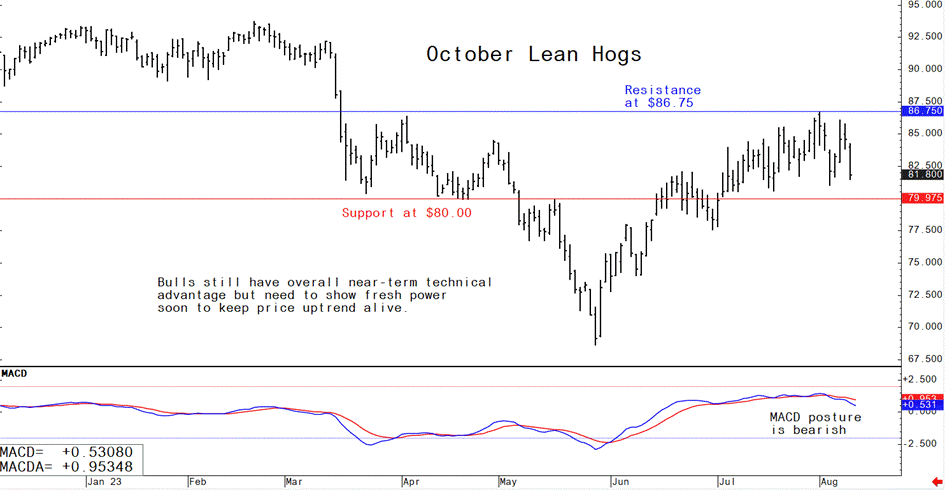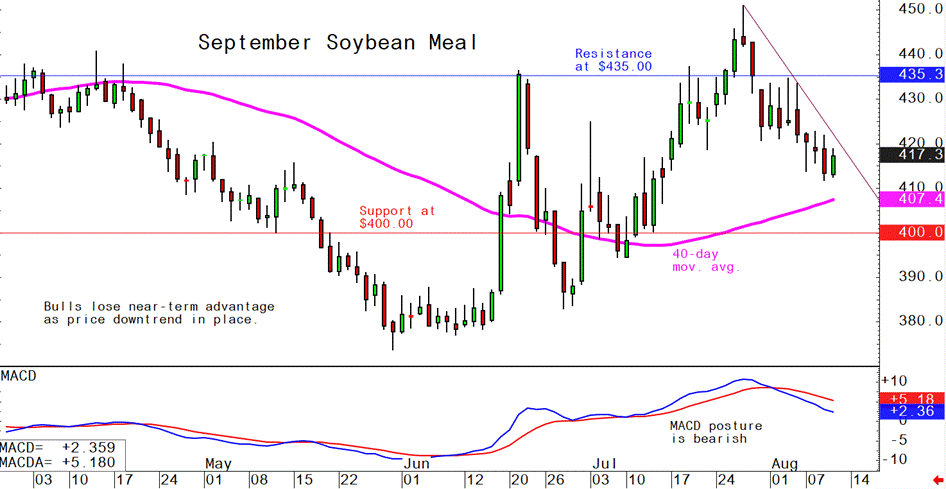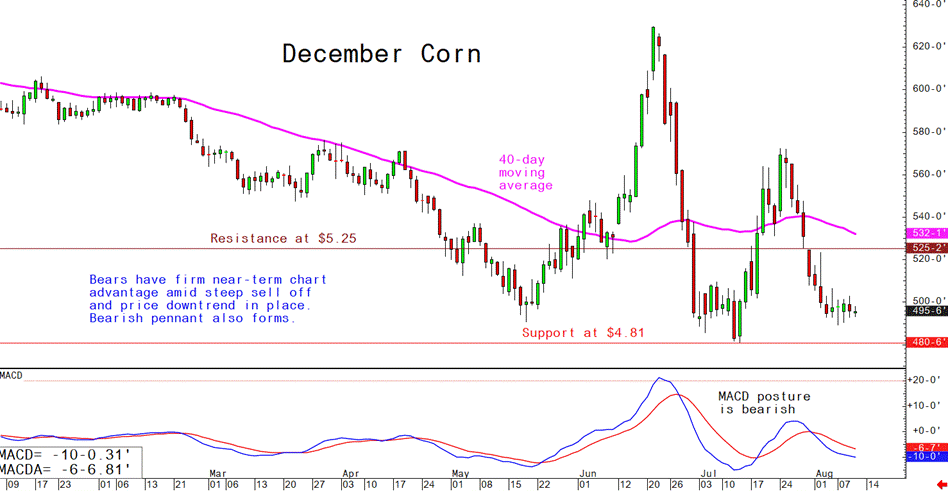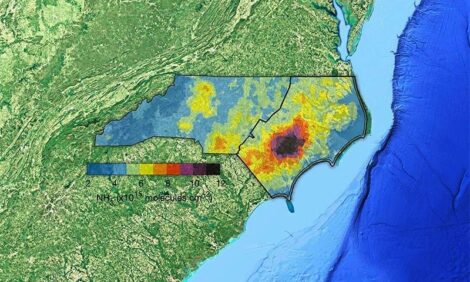



Pig outlook: Lean hog futures bulls need to show fresh power soon
Livestock analyst Jim Wyckoff shares the week's global pig newsOctober lean hog futures prices have seen a price uptrend on the daily chart stall out. The bulls need to show fresh power soon to keep the price uptrend alive, which would then suggest more upside price potential. The latest CME lean hog index is down another 24 cents, marking the seventh decline in the last nine days. August lean hog futures finished Wednesday $2.69 below today’s cash quote, signaling traders expect more price pressure. Hog traders seem overly bearish in the futures market, expecting a further drop than the seasonal tendency and pricing in more weakness in the cash market. However, export demand has kept up well above year ago levels, with June exports 9.5% above year-ago, though they fell 5.5% month-over-month. Pork demand should continue to perform well, as cattle prices remain near all-time highs.
Weekly USDA US pork export sales
Pork: Net US sales of 22,300 MT for 2023 were up 25 percent from the previous week and 3 percent from the prior 4-week average. Increases were primarily for Mexico (6,000 MT, including decreases of 300 MT), Japan (4,500 MT, including decreases of 100 MT), China (3,000 MT, including decreases of 100 MT), Colombia (2,500 MT, including decreases of 300 MT), and South Korea (1,700 MT, including decreases of 400 MT). Exports of 26,800 MT were down 1 percent from the previous week, but up 12 percent from the prior 4-week average. The destinations were primarily to Mexico (13,000 MT), China (3,800 MT), Japan (3,100 MT), Canada (2,000 MT), and South Korea (1,500 MT).
China warns of crop, animal disease outbreaks in flood-hit areas
Northern China warned of crop and animal diseases breaking out as flood waters retreated from rural areas. Local authorities must step up measures to prevent and control major disease outbreaks caused by dead animals, pests and insects, Ag Minister Tang Renjian said. He noted, “Agricultural and rural departments at all levels should accurately assess the disaster situation of farmers, help the affected farmers solve practical difficulties, and prevent disaster-caused poverty or return to poverty.”
China’s meat imports inch up
China imported 679,000 MT of meat during July, a 2.1% increase from June and 5.6% more than last year. China doesn’t break down meat imports by category, though the increase was driven by stronger pork arrivals. China imported 4.49 MMT of meat in the first seven months of the year, up 9.5% from the same period last year.
Settlement clarifies new regs to Massachusetts Question 3
A federal judge on Monday approved a compromise joint motion between state regulators and industry groups, who had challenged the voter-approved law, that allows enforcement of most pork-related regulations to begin Aug. 24. Products that pass through Massachusetts on their way to final sale destinations in other states, however, will not immediately be subject to the new requirements.
As part of the deal, Attorney General Andrea Campbell’s office and the Massachusetts Department of Agricultural Resources (MDAR) will not enforce any new restrictions on “transshipped” pork meat for at least six months. In that span, MDAR will work on a regulatory carveout explicitly exempting products that traverse the Bay State but are neither produced nor sold in the state.
“We’re going to finally see implementation. We just want to make sure that the plaintiffs in the case are not going to continue to work to undermine proper implementation,” said Wayne Pacelle, president of the Animal Wellness Action group and an architect of the Massachusetts ballot question. “I think our concerns now go to whether the people in the retail industry are going to honor the spirit and the letter of the law.”
The drafted regulations require pigs to have enough space to lie down, stand up, turn around freely and fully extend their limbs. Massachusetts businesses cannot sell any whole pork meat derived from animals denied that space, regardless of where they were raised, slaughtered, and butchered. The prohibition does not extend to “combination food products” that use pork as an ingredient such as hot dogs.
Of note: Almost all of the pork sold in Massachusetts comes from other states. According to statistics cited in one lawsuit challenging the pig welfare law, Massachusetts residents consumed about 356 million pounds of retail pork in 2022, only about 1.9 million pounds of which was produced within its borders.
Background. The Restaurant Law Center, four state associations, the National Pork Producers Council (NPPC), and the Massachusetts Attorney General’s Office reached a settlement providing clarity and new regulations to Massachusetts Question 3 (Q3).
The terms of the settlement state the Q3 regulations won't apply to whole pork meat that's already in the supply chain as of Aug. 23, nor will they apply to whole pork meat that was raised and sold to an out-of-state consumer. Also, if pork destined for out-of-state restaurants passes through distribution centers in Massachusetts, it will not be subject to Q3, even if a sale occurs in the state. The outcome allows impacted stakeholders more time to avoid supply disruptions.
Q3 was put into law in 2016, setting a ban on the sale of pork from establishments not meeting state's confinement standards. The pork industry was given two years to adapt to these regulations. However, the effective date for Q3 was delayed to August 2022 due to amendments to the law. The Restaurant Law Center and NPPC initially contested the constitutionality of Q3 in court in August 2022. The adjudication was put off until 30 days after the verdict on California's Proposition 12 — a comparable animal confinement state law — was reached. In May, when the U.S. Supreme Court validated Prop 12’s constitutionality, the case stay period was extended to Aug. 23.
Of note: With the recent settlement, issues not covered by the Supreme Court decision, particularly transshipment through Massachusetts, have been resolved. This is important because allowing a state to dictate what products are sold or consumed elsewhere could significantly impact the national supply chain.
A request has been made to a federal court judge to approve this settlement agreement.
Future regulation of genetically modified bacon, steak, and fish is the subject of a debate in Washington
The White House is deciding if this matter whether it should fall under the jurisdiction of the Food and Drug Administration (FDA) or the Agriculture Department (USDA), according to the Wall Street Journal.
Food companies favor gene-edited cattle and fish since they can grow larger and more quickly and are more adaptable to environmental changes and disease. These companies want USDA oversight due to its speed and cost-effectiveness compared to the FDA.
However, consumer and environmental groups prefer FDA regulation due to its expertise in complex scientific matters and concerns over potential collusion between the USDA and the industry.
FDA has primarily controlled the sector so far, approving five products and tagging 45 genetically modified animals as low risk. The market for these animals is forecasted to rise from $4.2 billion in 2020 to $6.4 billion by 2027.
Companies argue that as this technology matures and genetically engineered animals become more common, oversight should shift to the USDA, which already governs gene-edited plants. They find the FDA’s oversight process to be long and costly.
FDA and its supporters insist that the agency already has the necessary legal authority and expertise to mitigate possible dangers. They argue for careful supervision, citing the instance of genetically engineered cows which unexpectedly carried antibiotic-resistant genes. Those advocating for the FDA claim the agency is trying to be more efficient and has drafted guidelines awaiting White House approval. They also express concern about the USDA’s closeness to the industry, thereby affecting proper regulation.
USDA has tried to win oversight before, the WSJ article notes, with the Trump administration planning to hand over this sector's regulation, but without success. The Biden administration's recent budget proposal, however, favors USDA with budget allocated for the development of expertise to regulate gene-edited animals.
A recent law in California, Proposition 12, has initiated a potential hike in bacon prices
This is centered around wholesale costs for pork belly, the section of meat from which bacon is derived, seeing a sharp rise over the summer. The increase is partly influenced by an animal-welfare law in California, which mandates that pigs be allotted a minimum of 24 square feet of pen space.
Pork producers were initially apprehensive about purchasing new products following the Supreme Court ruling on Proposition 12 due to uncertainties about its implementation. They were concerned about investing in products that might not adhere to the new standards. However, in June, a deal was struck in California allowing producers to sell their existing inventory until the end of the year. This led to a surge in prices as buyers stocked up before the full enforcement of the law.
Aside from Proposition 12, a typical seasonal shift has also been observed, with pork-belly prices usually increasing during the summer due to a slowdown in hog slaughters and pork production. Unusually, this year's spike in prices has been unprecedented in the last decade, excluding the impact of the Covid-19 pandemic.
Pork belly's frozen reserves dropped by 14% in June compared to May. Even with this decrease, inventories are higher than usual due to a previous oversupply that had been pressuring wholesale pork prices downwards.
The WSJ item says consumers might not directly feel the changes in wholesale prices as retailers can adjust in various ways. In some cases, a rise in wholesale costs even led to lower retail prices as many large bacon suppliers source their own pork bellies.
Customer demand for bacon saw an increase with bacon package sales volume rising by 3.2% in the four weeks leading to June 17, bolstered by the easing of wholesale pork-belly prices earlier in the year. Over 80% of supermarkets continue to promote bacon products, an increase from 73% the previous year.
Regarding Proposition 12, its actual effect on bacon prices over the coming months remains unclear, according to the article. A majority of the U.S. pork is not compliant with the new law and some suppliers may choose to stop selling in California instead of adjusting their practices, which could lead to higher retail prices in California and lower prices elsewhere in the country due to an increased supply.
Bottom line: Amid these changes, the price of wholesale pork belly is expected to remain high. This is because livestock producers are struggling to manage the heat this summer, and the extreme heat expected in August could lead to animal casualties and reduced herd sizes.
US House Ag Committee Chairman Thompson intends to constructively address the California Proposition 12 using the farm bill
This is in response to the Supreme Court's decision to uphold the proposition to prevent a potential chain of inconsistent laws affecting interstate commerce.
Speaking at Farm Fest in Redwood County, Minnesota, Thompson implied that the Supreme Court allowed Proposition 12 due to their frustrations with carrying out duties they believe should fall onto Congress. He suggests this is a matter that needs correction, though he did not provide further details as to whether his proposed farm bill would draw from existing legislative suggestions by other lawmakers or establish its own distinct terms.
There are a range of opinions regarding this legislation on a federal level. While some favor the approach to avoid the issue that Thompson has identified, others are opposed. This includes entities that have already invested in compliance with the Proposition 12 stipulations. They are generally against any measures that would nullify the California law and prevent the implementation of similar requirements by states or local governments in the future.
USDA's Agricultural Marketing Service (AMS) has submitted the final rule to establish organic livestock and poultry standards
The measure goes to the Office of Management and Budget (OMB). This rule aims to set comprehensive practice standards for organic livestock and poultry production. These standards involve amendments to current regulations concerning livestock and poultry living conditions.
Areas of focus include ensuring outdoor access for the animals, optimizing their housing conditions, and managing stocking densities. The rule also touches on animal health care provisions, addressing issues such as physical alterations, medical treatment administration, and euthanasia procedures. Additionally, the rule covers topics related to the transportation and slaughter of these animals.
USDA had extended the public comment period in November on this proposed rule, and the OMB conducted five meetings to discuss the rule initially released in August 2022. The OMB's task is now to review this final rule.
The next week’s likely high-low price trading ranges:
October lean hog futures--$80.00 to $86.75 and with a sideways-higher bias
September soybean meal futures--$400.00 to $435.00, and with a sideways-lower bias
December corn futures--$4.81 to $5.25 and a sideways-lower bias
Latest analytical daily charts lean hog, soybean meal and corn futures











